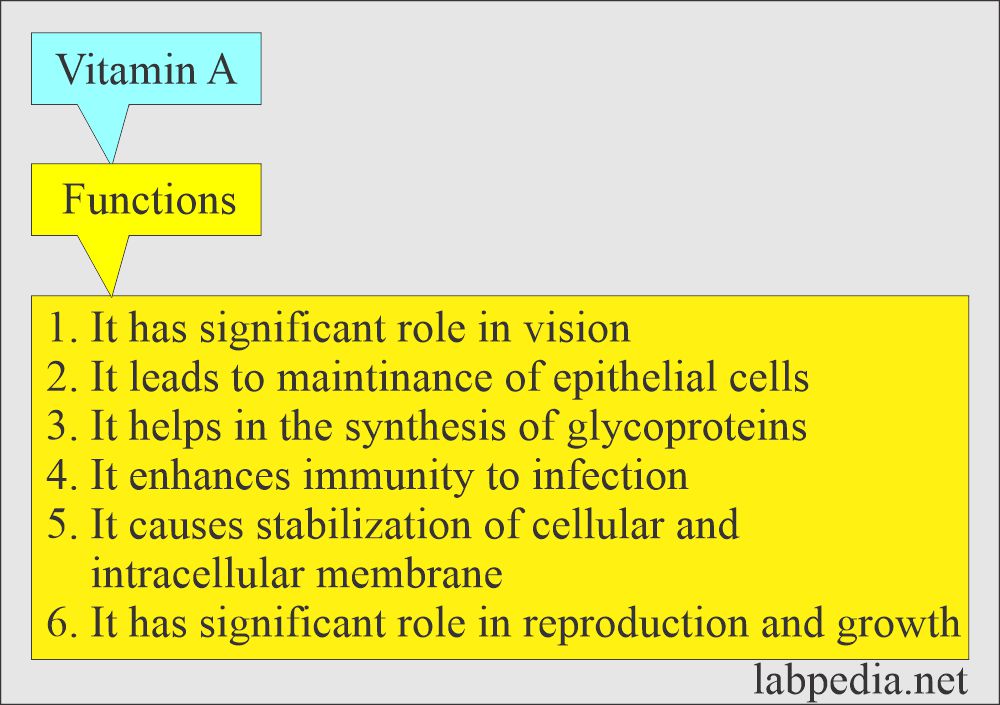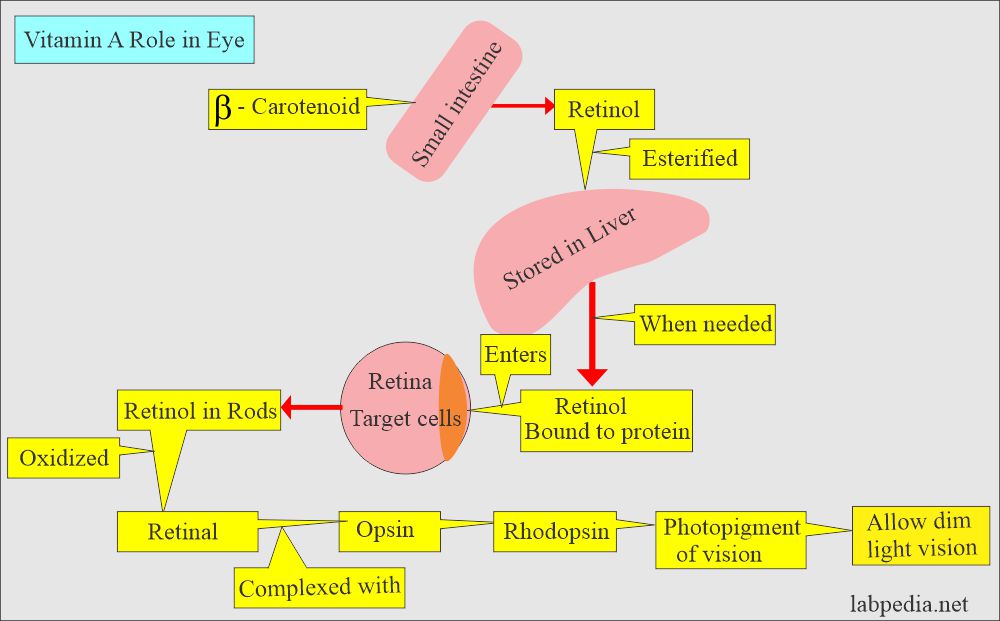Vitamin A (Retinol, Retinoid and Carotenoid)
Vitamin A (Retinol)
What sample is needed for the estimation of Vitamin A?
- Serum or plasma is required.
- A fasting sample is preferred.
- The sample is stable for 4 weeks at 4 °C
What are the precautions for Vitamin A?
- Avoid hemolysis.
- Avoid samples from the light.
- Do not ingest alcohol 24 hours before the blood draw.
How will you define Vitamins?
- The name of the vitamin was given by a Polish chemist, Casimir Funk, in 1991.
- He discovered a nutrient that could cure the Beri Beri in pigeons.
- He suggested that amines are present in food and that they prevent diseases.
- Vitamin = vita means life, so he named these substances vitamins.
- Vitamins are necessary for life.
- The deficiency of a single vitamin is usually uncommon.
- Vitamin deficiency may be due to an inborn error of metabolism or restricted diet intake.
- Vitamins are needed in µg or mg per day for the body’s normal metabolic function.
- These may be water-soluble or fat-soluble.
What are the fat-soluble vitamins?
- Vitamin A.
- Vitamin D.
- Vitamin E.
- Vitamin K.
- These are stored for a longer time.
- These vitamins don’t function as coenzymes.
What are the water-soluble vitamins?
- Vitamin B complex.
- Vitamin C.
- Lost for a short time.
- These function as coenzymes for numerous important enzymatic reactions.
Vitamin A (Retinol; Retinoic acid; Carotenoids)
How will you describe the history of vitamin A?
- It was described in 1909 that vitamin A prevents night blindness.
- In 1925, it was found that vitamin A consists of three biologically active forms.
- Retinol.
- Retinal.
- Retinoic acid.
- These are directly derived from the dietary source, primarily as retinyl esters, or from the metabolism of dietary carotenoids, such as provitamin A.
How would you discuss the pathophysiology of Vitamin A?
- Vitamin A is an essential nutrient.
- Vitamin A is found in:
- A diet rich in retinyl esters.
- Metabolism of carotenoids, provitamin A, and it is primarily β-carotene.
- Diet sources are:
- Animal products (Vitamin A).
- Pigmented fruits (carotenoids).
- Vegetables (carotenoids).
- Vitamin A is stored in the liver and in the blood circulation and is bound to retinol-binding protein and transthyretin.
- Retinoids are natural and synthetic chemicals structurally similar to Vitamin A but don’t have the function of vitamin A.
- These are derived from dietary sources, mainly carotenoids.
- It is insoluble in water and soluble in organic solvents and mineral oil.
- Vitamin A is sensitive to oxygen and ultraviolet light.
- It is also known as retinol because it produces pigments in the retina of the eye.
- Vitamin A and provitamin A are absorbed in the presence of bile salts.
- These are taken up by the small intestine epithelial cells.
What are the functions of vitamin A?
- Vitamin A helps form and maintain healthy skin, teeth, skeletal and soft tissue, mucous membranes, and skin.
- It is needed for good vision.
- Needed for the growth of fetus and embryo (reproduction and growth).
- It has a role in the immune system.
- It helps in wound healing.
- It helps in growth.
- It helps in the reproductive system.
- It prevents cancers.
- Vitamin A is sensitive to oxygen and ultraviolet light.
- Vitamin A exists in three forms:
- Retinol (A1) is the most important form of Vitamin A.
- This is the transport form of the Retinol ester and also the storage form.
- This is oxidized to aldehyde retinal, which is used in visual pigments.
- Also oxidized to retinoic acid.
- Retinal.
- Retinoic acid.
- Retinol (A1) is the most important form of Vitamin A.
What is the role of Vitamin A in the eye?
- The physiologic role of retinol is well elaborated in eye vision.
- Retinol is oxidized in the rods of the eye into the retinal. This will complex with opsin and form rhodopsin.
- Rhodopsin will allow dim-light vision.
What are the signs and symptoms of deficiency of Vitamin A?
- Vitamin A deficiency leads to the degeneration of the eyes and skin.
- There may be a Vitamin A deficiency of night blindness (nyctalopia).
- When the deficiency is prolonged, the patient may experience total blindness.
- The patient may have Dry eyes (Xerophthalmia).
- Dryness of the conjunctiva (xerosis conjunctivae) is present.
- There are Bitot spots.
- There is keratomalacia and, ultimately, blindness.
- Sometimes, patients develop diarrhea.
- The patient may develop skin problems.
- There are metaplastic changes in the epithelium of the lungs (squamous metaplasia).
- Metaplasia in the urinary tract leads to stone formation.
- The patient develops an immune deficiency.
- Common infections like measles, pneumonia, and diarrhea are serious in these patients.
- Recurrent infections.
- There is retardation of growth.
- There is an abnormal taste.
- Summary of Vitamin A deficiency:
- It is essential for vision, cellular differentiation, growth, reproduction, and immune system function.
What are the causes of vitamin A deficiency?
- Chronic fat malabsorption.
- Impaired liver function.
- Severe stress.
- Protein malnutrition.
- Premature babies are born with a deficiency of retinol and retinol-binding protein.
What are the dietary sources of vitamin A?
- Eggs.
- Fish liver oil.
- Dairy products like milk, yogurt, cheese, and butter.
- Meat includes beef, chicken liver, and calf.
- Vit. A1 is present in the liver of mammals and saltwater fish.
- Vit. A2 is found in freshwater fish oils.
- Vegetables like carrots, squash, and spinach contain a lot of vitamin A.
- Fruits and vegetables contain carotene, which is the precursor of the retinol.
What are the overdosage side effects of vitamin A (Vitamin A toxicity)?
- Acute intoxication after ingestion of 150 to 600 mg/day (500,000 to 2,000,000 IU).
- Chronic intoxication occurs after the ingestion of 7.5 to 90 mg/day (25,000 to 300,000 IU) for a minimum of one month up to 2 years.
- Acute toxicity shows raised intracranial pressure and skin desquamation.
- Increased risk for teratogen.
- Chronic toxicity shows liver damage, skin changes, and exostosis.
- This can lead to liver failure.
- The patient may develop headaches, fatigue, and muscle joint pains.
- The Patient skin is dry.
- The patient may develop nausea and diarrhea.
- There is hair loss.
- Chronic toxicity leads to weight loss, nausea, and vomiting.
- What are the lab findings of Hypervitaminosis A?
- Increased ESR.
- Increased Serum Alkaline phosphatase, GGT, and bilirubin.
- Decreased serum albumin.
- Decreased hemoglobin.
- Mild proteinuria.
- Increased PT.
- Mild increase in serum carotene.
What is normal Vitamin A?
Source 1
| Age | µg/dL |
| 1 to 6 years | 20 to 43 |
| 7 to 12 years | 26 to 49 |
| 13 to 19 years | 26 to 72 |
| Adult | 30 to 80 |
Other sources
- Daily requirements are:
- Infants (average intake)
- 1 to 6 months: 400 µg per day.
- 7 to 12 months: 500 µg/day
- Children (RDA)
- 1 to 3 years: 300 µg/day
- 4 to 8 years: 400 µg/day
- 9 to 13 years: 600 µg/day
- Adolescents and Adults (RDA)
- Males age 14 and older: 900 µg/day
- Females age 14 and older: 700 µg /day
- Or 65 to 275 I.U / 100 ml.
- Or > 20 µg / 100 ml.
- Infants (average intake)
- From other reference normal values for Vitamin A (Retinol) in the serum:
- 1 to 6 years = 20 to 43 µg/dL.
- 7 to 12 years = 26 to 49 µg/dL.
- Adults = 30 to 80 µg/dL.
- Severe deficiency = <10 µg/dL.
- Increased Vitamin A (hypervitaminosis) = >100 to 2000 µg/dL.
- Another source
- Recommended allowance of vitamin A:
- Adult male = 1000 µg/say.
- Adult female = 800 µg/say.
- Recommended allowance of vitamin A:
- Toxicity by daily ingestion chronic cases = >33,000IU.
- Toxicity acute = >500,000 IU.
- Toxicity causes hepatocellular necrosis and intracranial hypertension.
What is the normal Carotene level?
Carotene is a precursor of vitamin A.
- 100 to 300 I.U/100 ml or 40 to 300 µg/ 100 ml.
- Increased Carotene (Carotonemia) = >250 µg/dL.
Questions and answers:
Question 1: What is the role of vitamin A for eyes?
Question 2: What is the role of vitamin A in vision?




